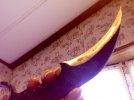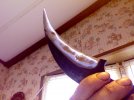- Joined
- Apr 10, 2007
- Messages
- 7,395
First off: Hello! I think this is my first post here, not sure why I waited so long.
I profiled-out a karambit yesterday and started to experiment with the bevel but I think I'm on the verge of wrecking it beyond hope of ever becoming a knife. I don't currently have access to a belt sander so I tried using my pedestal grinder and 4.5" angle grinder with only marginal success. It was near impossible to maintain my angle on the pedestal from start to finish. The 4.5 inch was easier to keep at the desired angle but was taking material off faster than I could control. I almost tried out the disc sander but I didn't want to make things any worse. My questions are: Is a belt sander the best option for grinding this type of blade shape? Would I be ok with a hand held disc sander (pneumatic) and a medium grit? I've never used an upright belt sander smaller than my grandfather's 6" so I'm not even sure if a small belt sander is what I should be thinking about.
Here's a pic of the blank so far to give you an idea of how much curve I'm working with:

The blank measures almost 9.5", ring to tip and about 5" of blade.
If it's simply a matter of practicing more with the tools I have, I'm perfectly willing. I just want to know which direction I should be heading.
Thanks!
I profiled-out a karambit yesterday and started to experiment with the bevel but I think I'm on the verge of wrecking it beyond hope of ever becoming a knife. I don't currently have access to a belt sander so I tried using my pedestal grinder and 4.5" angle grinder with only marginal success. It was near impossible to maintain my angle on the pedestal from start to finish. The 4.5 inch was easier to keep at the desired angle but was taking material off faster than I could control. I almost tried out the disc sander but I didn't want to make things any worse. My questions are: Is a belt sander the best option for grinding this type of blade shape? Would I be ok with a hand held disc sander (pneumatic) and a medium grit? I've never used an upright belt sander smaller than my grandfather's 6" so I'm not even sure if a small belt sander is what I should be thinking about.
Here's a pic of the blank so far to give you an idea of how much curve I'm working with:

The blank measures almost 9.5", ring to tip and about 5" of blade.
If it's simply a matter of practicing more with the tools I have, I'm perfectly willing. I just want to know which direction I should be heading.
Thanks!
Last edited:




